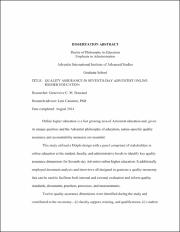| dc.description.abstract | Online higher education is a fast-growing area of Adventist education and, given
its unique qualities and the Adventist philosophy of education, nature-specific quality
assurance and accountability measures are essential.
This study utilized a Delphi design with a panel comprised of stakeholders in
online education at the student, faculty, and administrative levels to identify key quality
assurance dimensions for Seventh-day Adventist online higher education. It additionally
employed document analysis and interviews all designed to generate a quality taxonomy
that can be used to facilitate both internal and external evaluation and inform quality
standards, documents, practices, processes, and measurements.
Twelve quality assurance dimensions were identified during the study and
contributed to the taxonomy—(i) faculty support, training, and qualifications; (ii) student
support; (iii) infrastructure; (iv) institutional mission; (v) institutional commitment,
support, and leadership; (vi) stakeholder perceptions; (vii) curriculum design and review;
(viii) course design and development; (ix) instructional design and delivery;
(x) administration; (xi) program design; and (xii) the integration of faith and learning.
Eight themes identified in the data also contributed to the taxonomy—that (i) quality
assurance dimensions are shared by traditional and online education, (ii) online
dimensions differ from face-to-face dimensions in terms of their criticality, (iii) there are
five dimensions that are most notably critical to online education—faculty support,
training, and qualifications; student support; infrastructure; institutional commitment,
support, and leadership; and instructional design and delivery; (iv) the increased
criticality of the five dimensions is the result of the time and space distance introduced by
online learning, (v) a systems approach is vital to online quality, (vi) the extent to which
quality measures are applied with determine core competency, (vii) it is essential to
balance stakeholder needs in determining extent; and (viii) the integration of faith and
learning dimension pervades all the other dimensions.
In addition to being built on these dimensions and themes, the taxonomy was
anchored on the Adventist philosophy of education and the definition of quality as
“fitness-for-purpose” (Ali, 2012). It consists of three stages based on the identified
themes. The stages are further indicative of levels of quality.
Consequent to its findings, the conclusion of the study was that Adventist online
higher education is well-positioned to develop quality assurance measures collaboratively
in order to provide more universal benefit for its institutions, and that such an investment
is both timely and sound. | en_US |

